Peloton is one of the most recognizable brands in the US for a reason: The company has succeeded in building a home-workout empire around sleek fitness equipment, engaging fitness instructors, top-notch content streaming, and a feel-good, welcoming environment that (at the same time) feels elite. If you’re looking to upgrade your home gym setup with an exercise bike, or you’d like to dip your toe into the Pelo-verse, you may be looking at purchasing their Bike or Bike+. They’re solid pieces of workout tech, but they cost a pretty penny, going for $1,445 and $2,495 (at full price), respectively.
If those prices gave you sticker shock — or you need a bike with a higher weight limit or smaller footprint, for example — you’ve likely come looking for the best Peloton alternatives. Thankfully, you’ve come to just the right place. Our BarBend team has spent a lot of time combing the market for (and personally testing) the best exercise bikes out here, and we have a selection of machines that’ll give you a Peloton-like experience but are friendly to different budgets, homes, bodies, and other needs. Keep reading to see our eight picks for the best Peloton alternatives that’ll still let you ride nowhere in style.
The 8 Best Peloton Alternatives of 2025
- Best Peloton Alternative Overall: ProForm Studio Bike Pro
- Best Recumbent Peloton Alternative: Sole LCR Exercise Bike
- Best Peloton Alternative for Streaming: NordicTrack S22i
- Best Peloton Alternative Under $500: Sunny Health & Fitness SF-B1879 Synergy Exercise Bike
- Best Budget Peloton Alternative: Bells of Steel Blitz Spin Bike
- Best Peloton Alternative for Heavy People: Echelon EX-8s
- Best Peloton Alternative for Small Spaces: CAROL Bike
- Best Peloton Alternative with No Subscription: Stryde Bike
How We Tested and Chose the Best Peloton Alternatives
Workout equipment is our jam, and we have a lot of experience testing exercise bikes, specifically. Our BarBend team (including a few personal trainers) tried out more than 20 different exercise bikes, rating them on a scale of 1 to 5, with 1 being meh and 5 being stellar. Our testers scored the bikes across various criteria, including footprint, adjustability, and tech features. When analyzing stationary bikes to see if they’re worthy Peloton alternatives, we paid special attention to these categories in particular.
Dynamic Programming
Dynamic, high-quality programming is one of Peloton’s strengths, so it’s important to consider it when looking for another exercise bike that offers a similar experience. Some of these stationary bikes allow you to stream Peloton classes onboard their entertainment system or are friendly to a BYO-screen approach, while others offer workout streaming experiences that rival Peloton’s (or at least try to). We considered Peloton’s offerings when assessing all these alternatives, including whether they’re compatible with or hold a candle to the brand’s workouts.
Tech Capabilities
A key part of following Peloton cycling classes is tailoring your resistance and cadence to match the instructor’s cues. To do that — or to get a similar experience with another bike — you’ll want a machine with the right tech, including precise resistance adjustments, a cadence monitor, and perhaps a high-quality screen. To monitor your effort or progress over time, you’ll want one with a heart-rate monitor (or the ability to connect to one), and to get the most out of onboard entertainment, you’ll want Bluetooth capabilities (to connect to your headphones) or decent speakers. We kept an eye on all these techy draws when selecting the eight bikes below.
Price and Warranty
Peloton’s bikes are pricey, but they’re high-quality machines. When evaluating the Peloton alternatives below, we took price into consideration, with the goal of offering machines that fit a range of budgets while still honoring the amount of cash you’re putting in.
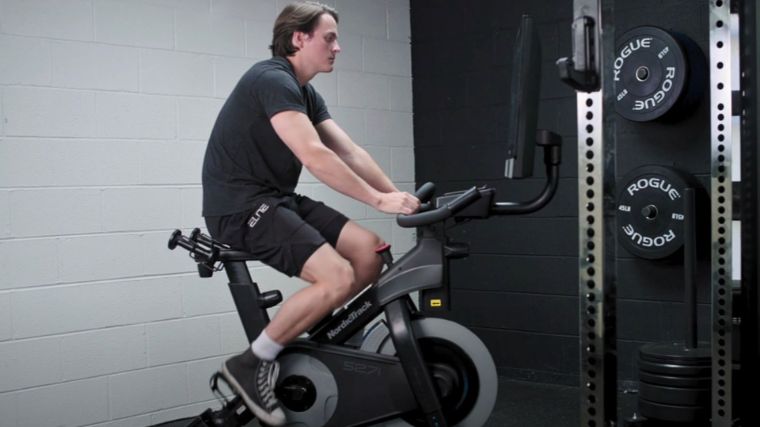
Part of assessing worth includes looking at the warranty — because what’s the point of spending money on something if there’s no guarantee it’ll last? Peloton offers a 12-month limited warranty on parts and labor for their Bike and Bike+, which includes coverage of the touchscreen and most original components, and five years for the frame. (The brand also offers Protection Plans that extend the warranty for a total of 48 months and come with additional benefits. They cost $149 for the Bike and $249 for the Bike+ — total, not per month or year.) We kept warranty in mind when looking at all the bikes below, and the good news is that many offer free-with-purchase protections that meet or surpass those provided by Peloton.
Best Peloton Alternative Overall: ProForm Studio Bike Pro
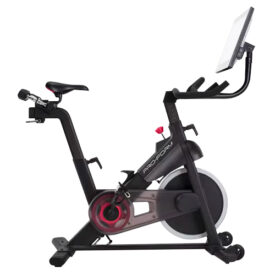
The ProForm Studio Bike Pro is a high-tech, high-quality indoor bike. It has a 10” HD touchscreen display that swivels 180 degrees to accommodate workouts both on and off the bike. It comes with three year free subscription to iFit and features silent magnetic resistance making it a great option of in-home use.
Specs
- Price: $1,404
- Dimensions: 52” H x 56.5” L x 21.9” W
- Weight: 140lbs
- Resistance: 22 levels of digital resistance
- Weight Capacity: 250lbs
Pros
- The ProForm Studio Bike Pro offers machinery and workout streaming that more or less matches the experience you’d get on a Peloton Bike.
- The bike is “free” with the purchase of a three-year iFIT Pro membership.
- This ProForm model automatically adjusts the resistance during scenic rides or instructor-led classes — you’d need to shell out $2,495 for a Bike+ to get that feature from Peloton.
Cons
- You can’t use this screen for anything other than iFIT and you’ll need to maintain a Pro membership ($39/month) to make the most of the bike.
- The ProForm has a 10” HD touchscreen, which is small compared to the Peloton Bike’s 21.5″ display.
- This model offers 22 digital levels of resistance, which is around the industry norm but limited compared to Peloton’s 100 levels.
- This bike has a relatively low weight limit of 250lbs, which is under industry standards and almost 50 pounds below Peloton’s max user weight.
Looking for a Peloton-like experience but under a different name — and, perhaps, at a better deal? Now’s the time to try the ProForm Studio Bike Pro.
It matches the Peloton Bike in terms of look and feel, and you can currently get it “free” when you buy a three-year iFIT Pro membership, which is typically $39/month. That means you get the bike and three years of iFIT (a combined value of $2,700) for just $1,404. (If you bought a Peloton Bike for $1,445, you’d then need to pay $44/month for the All Access Membership. Over three years, that’s a combined cost of $3,079.) Our tester gave the bike a 4 out of 5 for value based on this deal: “This setup is more affordable for many people, and gives you the membership, too, whereas with other bikes, you’d have to pay the monthly fee on top of the bike’s cost.”
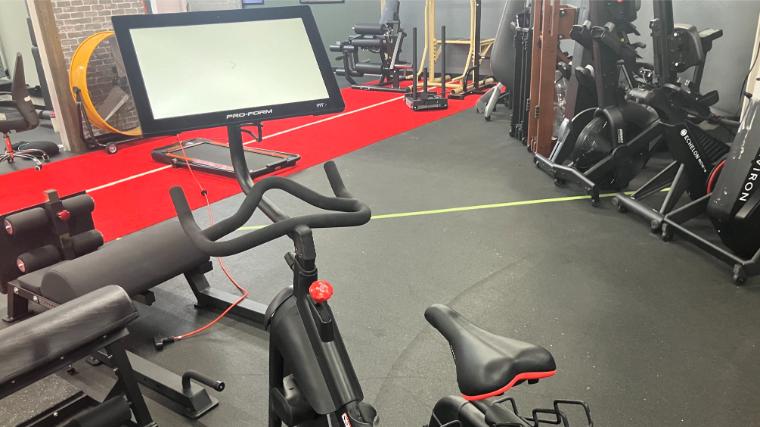
How does it compare to the Peloton Bike, exactly? The ProForm has a similar sleek design, steel frame, and footprint. They differ in terms of resistance levels (ProForm has 22 while Peloton has 100) and display size (Peloton’s Bike has a 21.5” screen while this one is just 10”). “The screen is a bit small, but workable, and can pivot for workouts off the bike. Overall, it’s quiet and stable, except the handlebars and screen wobble a little,” our tester said, giving it a 2.75 out of 5 for durability. “It’s a fine entry-level bike, but there are many others that have better specs,” they admit.
The ProForm earned higher marks for tech capabilities and dynamic programming: a 4 out of 5 and 4.5 out of 5, respectively. iFIT has thousands of on-demand studio-style classes and scenic rides that take you around the world — the latter of which Peloton doesn’t do. Something else you don’t get with a Peloton Bike? Automatic resistance adjustments. During iFIT classes, the Studio Bike Pro automatically adjusts the resistance to match the instructor’s cues or the terrain you’re riding through.
The downside of the iFIT integration is that you can’t use the bike’s display for anything else. If you’re looking to stream entertainment or try other workout platforms, this isn’t the bike for you — and after those three years of iFIT are up, you’ll need to pay $39/month for a membership to keep making the most of the machine.
Read our full ProForm Studio Bike Pro Review.
Best Recumbent Peloton Alternative: Sole LCR Exercise Bike
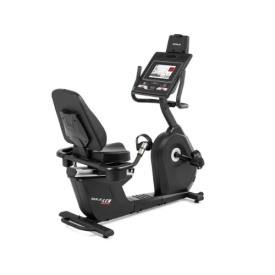
For those who like to stream workout videos while they train, this recumbent bike is a great pick. It comes with access to a free library of training videos and you get 40 resistance level options.
Specs
- Price: $1,799
- Dimensions: 60” H x 56” L x 29” W
- Weight: 152lbs
- Resistance: 40 levels of magnetic resistance
- Weight Capacity: 350lbs
Pros
- Recumbent bikes are gentler on your joints and offer a lower-impact workout for beginners, people with injuries, or those with limited abilities. (1)
- The Sole LCR can support riders up to 350lbs.
- The 10” touchscreen supports Bluetooth screen mirroring, so you can experiment with different workout platforms or entertainment apps.
Cons
- At about $1,800, this costs $300 more than a Peloton Bike.
- Many cycling classes (including Peloton’s) aren’t designed for recumbent bikes, so you may have trouble following along if that’s how you want to use the bike.
- You’re limited in terms of ride intensity; you can’t stand up to pedal or comfortably surpass a certain cadence.
If you’re into the idea of a Peloton so you can do guided, low-impact cardio at home but you’re looking for something a bit gentler, a recumbent bike like the Sole LCR could be a good fit for you. This specific type of stationary bike is especially great for beginners or those looking for lower-intensity workouts. The seat is typically positioned far behind the pedals, and the seat is larger and has a backrest. As a result, there’s less weight in your feet and legs, and your hips and torso are more supported.
“Recumbent bikes make cycling accessible to people who have injuries and/or mobility limitations. Thanks to the reclined positioning, stress and demand on the lower back is reduced, and the hips are allowed to remain in a more open position,” explains BarBend expert reviewer Amanda Capritto, CPT, CES, CNC, CF-L1, CSNC. “The back support from the chair also means that the individual can focus on power output from the legs and not have to worry about core stability.”
The catch here is that you’re also limited to a certain workout intensity. You won’t be able to comfortably pedal past a certain cadence, and you definitely won’t be able to ride out of the saddle. The Sole LCR does offer 40 levels of magnetic resistance, so you can still sufficiently challenge your legs and cardiovascular system, and the handles have built-in heart-rate monitors so you can track your efforts.
The 10” touchscreen has a few limited guided workout programs, but the options expand greatly when you factor in the Bluetooth and screen-mirroring capabilities; you can cue up Peloton workouts if you want, stream entertainment apps like Netflix, or use the brand’s free Sole workout app which offers guided workouts specific to their equipment.
The bike also comes with a wireless charging station, fan, and water bottle holder, which makes the experience on this bike pretty comfy and customizable overall. If you’re OK with limiting your workout intensity, it could be a good pick, though not necessarily an affordable one; at $1,800, the LCR is more expensive than a Peloton Bike.
Best Peloton Alternative for Streaming: NordicTrack S22i
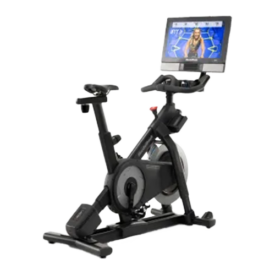
The NordicTrack Commercial S22i is high-tech and high quality, featuring both advancements like a 22” touchscreen display, and solid specs like 24 levels of quiet magnetic resistance.
Specs
- Price: $1,999
- Dimensions: 61″ L x 22″ W x 58″ H
- Weight: 205lbs
- Resistance: 24 levels of SMR Silent Magnetic Resistance
- Max User Capacity: 350lbs
Pros
- The NordicTrack S22i display comes integrated with iFIT, which offers thousands of on-demand classes across 10+ different modalities and pivots so you can work out off the bike.
- The S22i can incline up to 20 percent and decline to -10 percent — a feature unavailable on any Peloton models.
- This NordicTrack model automatically adjusts the resistance during guided workouts, a feature you’d have to pay $500 more for with a Peloton Bike+.
Cons
- At $2,000, this is about $500 more than the more basic Peloton Bike, and still requires a $39/month iFIT subscription after an initial 30-day free trial.
- The S22i has 24 levels of Silent Magnetic Resistance compared to Peloton’s 100 levels of resistance.
- You won’t be able to use the display for workouts or entertainment outside of iFIT’s offerings.
As far as clout goes, NordicTrack is up there with Peloton in terms of legendary fitness tech — and thanks to the iFIT integration in many of their machines, including the S22i Bike, they’re a worthy rival in terms of streaming content, too.
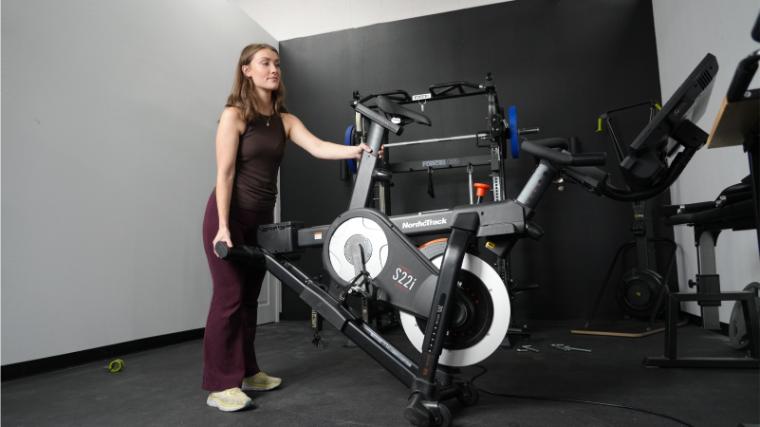
iFIT is regarded as one of the best fitness apps out there, with thousands of classes in their library across 10+ different modalities, including running, cycling, walking, hiking, strength, yoga, HIIT, and more. (To make the most of the latter, you can swivel the S22i screen to take classes off the bike.) Take it from BarBend expert reviewer Amanda Capritto, CPT, CES, CNC, CF-L1, CSNC: “NordicTrack is also known for its integration with iFIT programming, which is some of the best interactive fitness programming available, especially for cardio.”
The thing iFIT has that Peloton doesn’t? Their immersive, scenic classes: You can virtually pedal through the Swiss Alps or mountain bike around Southern Utah, exploring the world through the S22i’s 22” HD touchscreen while breaking a sweat. It’s pretty epic. “The touchscreen makes it look like you’re literally riding through Hawaii or sitting in a fancy cycling studio,” our tester said, giving it a 5 out of 5 for dynamic programming.
Our tester also scored it a 5 out of 5 for tech capabilities, based primarily on two key features: automatic adjustment of resistance during guided rides, as well as the incline and decline. To get auto adjustments with Peloton, you’d need to spend about $500 more and buy the Bike+, and you still wouldn’t get the incline/decline feature (which is, overall, super rare for an exercise bike). That’s one reason our tester gave it a 4.5 out of 5 for value, even if it comes in at about $500 over the price of Peloton’s entry-level Bike.
The thing is, if you’re buying this bike, you’re beholden to iFIT — both to stream any content, since it doesn’t work with any other platforms, and to make the most of the bike’s features. The bike comes with one month free, but after that, you’ll need to shell out $39/month for a Pro subscription (which, for what it’s worth, is $5 less than Peloton’s monthly cost). “With iFIT, this machine is a 5 out of 5,” our tester said. “The streaming platform is amazing. But without it, you essentially just have the bike in manual mode, which isn’t much to get excited about.”
Read our full NordicTrack S22i Exercise Bike Review.
Best Peloton Alternative Under $500: Sunny Health & Fitness SF-B1879 Synergy Exercise Bike
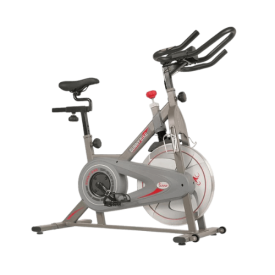
The SF-B1879 from Sunny Health and Fitness can be a great solution for budget-minded athletes wanting the performance of a magnetic resistance system along with a lightweight frame. A built-in LCD monitor can also be helpful in monitoring key training data like calories, speed, time, distance, and others.
Specs
- Price: $419.99
- Product Dimensions: 49” L X 22” W X 50.5” H
- Weight: 88.2lbs
- Resistance Type: Magnetic
- Weight Capacity: 275lbs
Pros
- The bike is almost $1,000 less than the lowest priced Peloton bike.
- It’s about 10” shorter in length, eight inches shorter in height, and more than 45lbs lighter compared to the Peloton Bike, making it great for small spaces.
- The bike has micro-adjustable resistance, just like a Peloton bike.
Cons
- There are no guided workouts, so you’ll need to stream content on a separate device or pedal on your own accord.
- Resistance is manually adjusted with a knob, which isn’t as precise as when it’s digitally controlled.
- You’ll need to BYO screen if you want to stream any content — though there’s a great media shelf for holding whatever device you use.
If you love taking cycling classes like those offered by Peloton but you’re looking to spend, like, $1,000 less than they want for your Bike, there’s good news: You can get a decent cycling-style exercise bike for under $500. Our choice is this model from Sunny Health & Fitness. It’s simple and low-tech, but is a perfect basic machine for doing studio-style cycling workouts on a budget. Even better? It’s often marked down to even less — we’re talking about $300.
Weighing just 88.2 pounds, this bike is easy to move around and has a small footprint due to the fact that it doesn’t have a built-in display; our tester gave it a 5 out of 5 for footprint and portability. Even so, it’s solid. Our tester gave it a 5 out of 5 for durability as well as adjustability and ergonomics. “The bike feels super sturdy even when you’re riding out of the saddle. I think the lack of a huge screen actually makes it less shaky when you’re riding,” they said.
You can adjust the seat four ways and the handlebars two ways, and easily swap out the seat if you’d like. Despite being affordable, it offers a smooth ride. The 30-pound flywheel is just eight pounds less than the one on both Peloton models, which isn’t bad for a budget bike. (Generally speaking, the heavier the flywheel, the smoother the ride.)
Tech capabilities, which our tester gave a 3 out of 5, are limited. There’s a device shelf so you can stream workouts or watch TV on your phone or tablet, and a basic display that rotates between showing speed, distance, time, calories, RPM, and heart rate, thanks to the built-in pulse sensors on the handles. You can then pull your stats into the free Sunny Health & Fitness app and keep a detailed record of your rides — that is, with the help of a cadence sensor that clips onto the bike and is free when you buy the machine on Sunny’s website.
“If you want a basic bike without all the frills, this gets the job done for a low price,” our tester said, giving it a 4.5 out of 5 for value. Just note that the warranty is appropriate for the price point; there’s a 3-year warranty on the frame and 180 days on other parts and components.
Best Budget Peloton Alternative: Bells of Steel Blitz Spin Bike
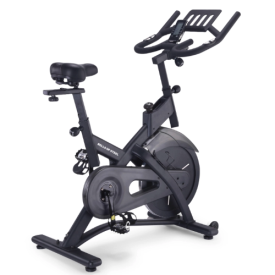
This bike costs almost $900 less than Peloton’s most affordable exercise bike option, and it comes with a media shelf for streaming from any fitness platform. It also boasts a heavy 44-pound flywheel.
Specs
- Price: $599.99
- Product Dimensions: 53” H x 44’’ L x 21.5” W
- Weight: 117lbs
- Resistance Type: Magnetic
- Weight Capacity: 297.62lbs
Pros
- This bike costs nearly $900 less than Peloton’s most affordable exercise bike option, and doesn’t come with any mandatory subscription cost.
- The Blitz Spin Bike has a 44-pound flywheel, which is heavier than Peloton’s bikes.
- The spacious media shelf means you can stream whatever content you want on your own device.
Cons
- The seat and handlebars both adjust four ways but only have six drilled-hole height settings, which is extremely limited compared to Peloton’s 28 inches of stepless adjustments.
- This bike has a 297lb weight capacity, which matches Peloton’s but isn’t the highest we’ve seen on an exercise bike.
- There aren’t any customer reviews of this bike available on the Bells of Steel website (yet), so it’s impossible to know what other customers think about it.
If you’re looking for a budget-friendly Peloton alternative but are willing to spend a little more than $500 for a more solid machine, give the Bells of Steel Blitz Spin Bike a look. This bike rings up at about $600, which is nearly $900 cheaper than Peloton’s Bike at full price. You sacrifice some of the major features — namely, there’s no built-in display — but if you’d rather spend your money on a place to pedal rather than more tech, it could be just the thing.
The Blitz Spin Bike has magnetic resistance and a 44-pound flywheel, which is heavier than those on Peloton bikes, and helps ensure a smooth and quiet ride. It has drip guards to shield the bike from sweat, and a grippy, rubber-coated media shelf to hold your phone, tablet, or other device while you ride.
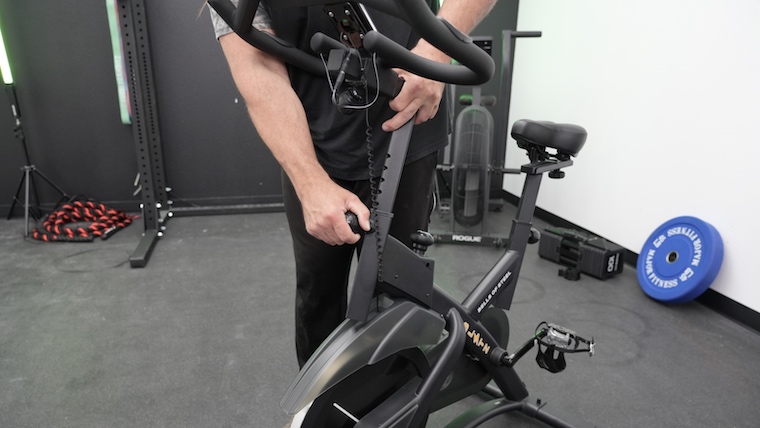
The perks of a BYO-screen bike are that you’re not stuck with one workout streaming service like Peloton or iFIT, and you can also read or watch TV. If you already own a handful of screens, it can also feel more reasonable to use one you already have than buy another that’s stuck on a bike. The downside is you won’t get app access to ride metrics or other stats that come with digitally connected bikes (though there is a small console that offers basic data tracking).
If you’re planning to do a lot of riding or indoor training for road biking, you may want to consider the adjustability and ergonomics, too. The seat and handlebars both adjust forward/back and up/down, and the seat angle is adjustable for comfort; however, the seat height settings are available as six holes drilled into the post every inch or so.
This doesn’t offer a lot of options to find exactly the right fit, especially when you compare it to Peloton’s bikes, which have 28 inches of stepless adjustments with markers down to the quarter inch. If you’re hopping on for the occasional cardio session, that might be enough, but cycling regularly with an ill-fitting bike setup can lead to more pain or injury and affect your performance. (2)
A highlight? The Blitz bike comes with a lifetime frame warranty, which is almost unheard of for exercise bikes. It may not have all the bells and whistles, but this model is physically solid and that should get the job done for a relatively low price.
Best Peloton Alternative for Heavy People: Echelon EX-8s
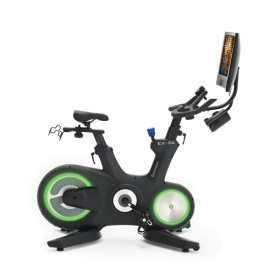
The Echelon EX-8s can glam up your home gym with a dual-flywheel design outfitted with LEDs you can customize by color, tempo, and brightness. The 24-inch touchscreen is curved to offer a deeper sense of immersion during classes on the Echelon Fit app.
Specs
- Price: $2,999.99
- Dimensions: 65’’ H x 59’’ L x 23’’ W
- Weight: 124lbs
- Resistance: 32 levels of quiet magnetic resistance
- Weight Capacity: 300lbs
Pros
- The EX-8s has a user weight limit of 300lbs, which is about level with industry standards and a few pounds more than both Peloton bikes.
- It has a curved 24″ HD touchscreen and 15 LED flywheel lights.
- The EX-8s has a sleek and unique look with a dual-ring design we’ve seen on few other exercise bikes.
Cons
- This is the most expensive bike on this list, costing $500 more than Peloton’s more expensive model, the Bike+.
- Customers note that the Echelon Fit app and classes aren’t as good as competitor streaming options like Peloton or iFIT.
- The bike has 32 digital resistance levels, less than Peloton’s 100, and it doesn’t automatically adjust like other high-end bikes in this price range.
Bigger-bodied athletes may worry about the weight limit of stationary bikes, and the truth is that it’s hard to find one with a limit above 300lbs. (There’s a reason we have a dedicated list of the best exercise bikes for heavy people.) The Echelon EX-8s tops out right at that mark, with a limit a few pounds above Peloton’s max of 297lbs. The EX-8s also has some one-of-a-kind features, including a shock-absorbing steel frame that flexes slightly with your movements and which may be more comfortable for heavier riders.
It’s also pretty sleek, and if you’re entertaining the idea of buying a Peloton for the aesthetic alone, the look of this bike might make you do a double take. The EX-8s has a dual-ring design, which makes it look like it has two flywheels, and they’re fitted with 15 rainbow LED lights that change color to sync with your riding intensity. In reality, there’s just one 38-pound wheel, which goes toe-to-toe with Peloton’s flywheels of the same weight, and which ensures an equally smooth ride.
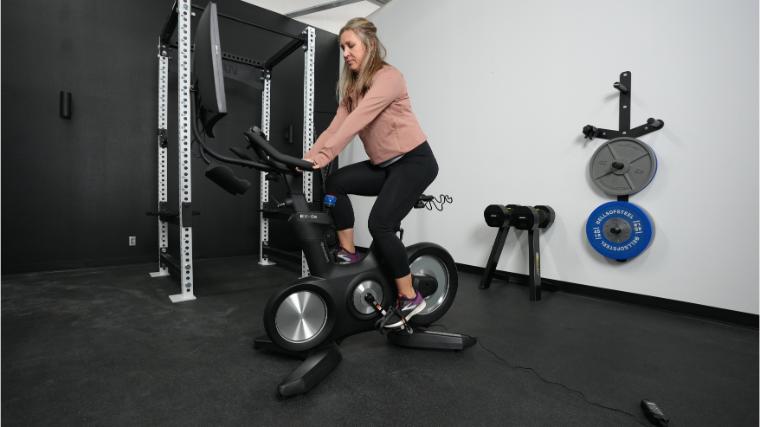
“Overall, the tech capabilities are really impressive,” our tester said, scoring it a 5 out of 5 on that metric. “There are dual-facing speakers, a Bluetooth resistance controller, audio jacks, a camera, a USB host, and the screen flips 180 degrees to view off the bike,” they said. However, unlike other high-end bikes in this price range — including the Peloton Bike+, which is $500 cheaper — the Echelon EX-8s doesn’t do automatic resistance adjustments when you’re taking guided classes.
Speaking of classes: The brand has their own workout streaming platform which offers daily live classes, challenges, a huge library of on-demand workouts, and scenic classes similar to JRNY or iFIT (and which Peloton, for the record, doesn’t have). It’ll cost you $40 per month for the Premier Membership, which gives you access to classes on your bike and also bumps the warranty up to five years while being $4 cheaper per month than Peloton’s comparable All Access Membership. “They’re doing a decent job, but the production quality isn’t quite there yet for the amount you’re paying,” our tester said.
Read our full Echelon Connect EX-8s Exercise Bike Review.
Best Peloton Alternative for Small Spaces: CAROL Bike
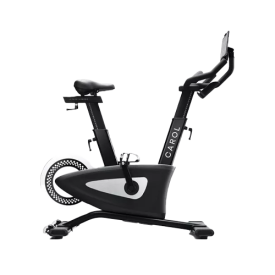
The CAROL bike's AI capabilities provide you with tailored training, designed to give you the best workout in the least amount of time. Customers have a 100-day trial period to decide whether or not this bike is right for them.
Specs
- Price: $2,595
- Dimensions: 45.5″ L x 22″ W
- Weight: 120lbs
- Resistance: AI-controlled, motorized resistance
- Weight Capacity: 330lbs
Pros
- The CAROL Bike is more than a foot shorter in length than the Peloton Bike or Bike+ and weighs 15 to 20lbs less.
- CAROL coaches you through personalized high-intensity interval training workouts using AI-powered automatic resistance adjustments.
- The display is unlocked, so you can add other workout and entertainment apps.
Cons
- You’ll need to pay $15/month for access to the bike’s best features, including AI optimization and detailed performance metrics — and that’s on top of a $25/month Peloton subscription if you plan to take those cycling classes.
- This is the second most expensive bike on this list and costs $1,000 more than the Peloton Bike.
- The 10” touchscreen is lackluster compared to the 23.8″ one you get with the similarly-priced Peloton Bike+.
A stationary bike with a big HD screen may seem nice in theory, but the reality is that the display can drastically increase the visual and literal space a machine takes up in your living room or home gym. When you’re working with limited square footage, getting the smallest exercise bike possible might be an important goal — and the CAROL is a great option, especially as a Peloton alternative.
This bike takes up significantly less space than either of Peloton’s models, requiring only 45.5” from tip to tail. Its small stature is possible thanks partly to its slim steel frame and unique rear-flywheel design. The 11.5” touchscreen display isn’t flashy, but gets the job done, and at less than half the size of the screen on the Peloton Bike+, it helps cut down on the bike’s size and weight. It’s just 120lbs and easy to move thanks to transport wheels, which helped earn the CAROL Bike a 4.5 out of 5 for footprint and portability with our tester.
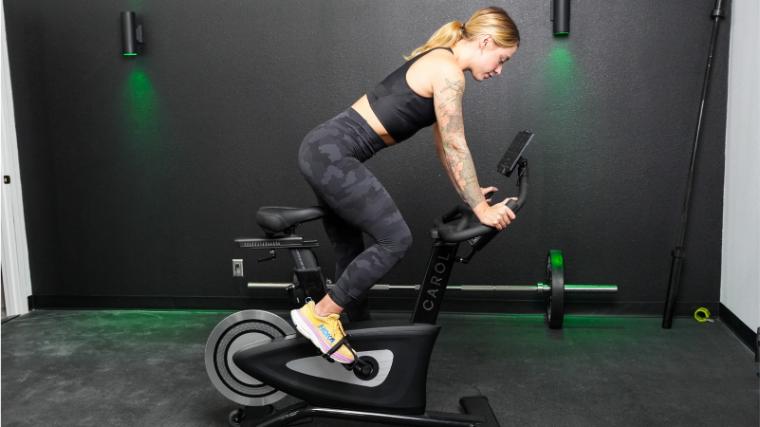
And this sleek little bike packs a punch. “It has a frictionless magnetic brake and is belt-driven, which makes it both quiet and extremely durable,” our tester said, giving it a 4 out of 5 for durability. But its defining feature is the AI-powered mechanical resistance and proprietary scientifically-backed workout programs it offers. “When you’re doing one of CAROL’s workouts, the bike automatically and instantly applies the ‘correct’ amount of resistance to get you to work at a certain intensity, and changes from ride to ride based upon your performance,” our tester said. “It’s really cool; I’m a massive fan.”
They gave the bike a 4 out of 5 for its tech capabilities because the AI workouts are stellar, but in the end, the built-in display is just an Android tablet. This has a perk — total flexibility, including being able to stream whatever workouts or entertainment you want, including Peloton’s app — but the downside is that it isn’t as high-end as the rest of the bike. And you are paying a high-end price: $2,595 ($1,100 more than the Peloton Bike and $100 more than the Bike+) plus a $15 subscription to access all the best features, including the AI workouts.
Read our full CAROL Bike Review.
Best Peloton Alternative with No Subscription: Stryde Bike
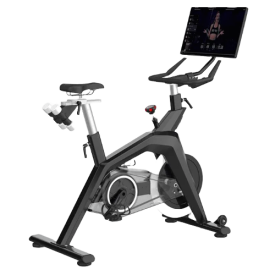
The Stryde Bike's 21-inch HD touchscreen is “unlocked,” so you’re not tied to a particular subscription service. It has 100 levels of magnetic resistance and you can use the Stryde app for $29.99 per month, but it is not required to use the bike.
Specs
- Price: $1,895
- Dimensions: 46” H x 49.6” L x 24” W
- Weight: 135lbs
- Resistance: 100 magnetic micro-adjustable levels
- Weight Capacity: 350lbs
Pros
- You’re not forced into a subscription to use the Stryde Bike, and the tablet is unlocked so you can cue up whichever apps or streaming platforms you please.
- The powder-coated steel frame supports riders up to 350 pounds — over 50lbs more than Peloton’s Bike or Bike+.
- It’s compact, measuring nearly a foot shorter in length and height than similar models.
Cons
- The Stryde Bike costs $450 more than the Peloton Bike, which is $1,445 at full price.
- Though the display is unlocked, our tester noted that downloading and troubleshooting issues with apps can be a pain.
- The seat is four-way adjustable, but the handlebars only move up and down.
When you’re shelling out a month’s rent payment for a bike that doesn’t go anywhere, being locked into an additional and indefinite $30+ monthly subscription cost can feel like getting scammed. The Stryde Bike solves that problem, with an unlocked Android touchscreen display and optional membership for $29.99/month.
Stryde allows you to download whatever apps you want and work out as you please. (They have their own workout app there with hundreds of classes from boutique studios across the country, if you so desire.) This is a fantastic Peloton alternative for those who like to flirt with different workout streaming services, or who want to do some free trials before locking into one they love. This flexibility earned the bike a 4 out of 5 for technology with our tester.
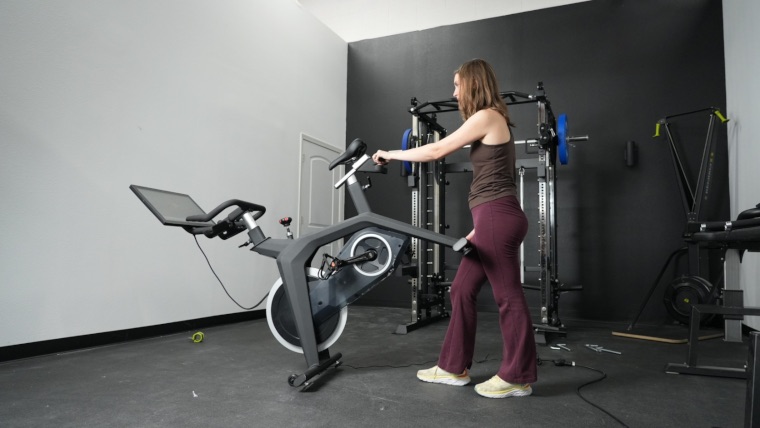
If you’re looking for an aesthetic bike, it’s not a bad option either. Glance quickly at a Stryde, and you just might think you’re looking at a Peloton. It may not have as much brand recognition, but the Stryde matches up with Peloton where it counts, going toe to toe with Peloton’s in terms of HD touchscreen size (21.5”), resistance (100 levels of micro-adjustable magnetic resistance), and warranty (5 years for the frame; 1 for screen, parts, and labor).
Then Stryde surpasses Peloton in two key features: the aforementioned streaming freedom, as well as the user weight limit; it supports riders up to 350lbs, compared to Peloton’s 297lbs. “The Stryde bike is heavy-duty and impressively sturdy,” they said. “I didn’t notice any shaking, even when I was pedaling out of the saddle during some climbs.” Our tester gave it a 3.5 out of 5 for durability.
Where does Stryde fall short? Downloading apps can be a pain, as the bike isn’t compatible with a user-friendly app store; instead you have to download APK files of the apps you want. And while the seat is four-way adjustable, the handlebars only move up and down — knocking the adjustability down to 3.5 out of 5 with our tester. In all, our tester said, “The Stryde bike is nothing to ride home about.” But if you price streaming freedom above all, it would be a solid Peloton alternative pick.
Read our full Stryde Bike Review.
Benefits of Peloton Alternatives
Most at-home exercise bikes come with more or less the same benefits in terms of helping you stick with your fitness goals and improve your mental and physical health. Opting for a Peloton alternative instead of one of the brand’s bikes can have some specific benefits of its own — these perks are less relevant for your health, but more about your workout experience, wallet, and living space.
Programming Variety
When you buy an exercise bike with a screen, there’s a very good chance you’re going to get strongarmed into a monthly subscription. That’s true with Peloton’s bikes, which leave you with only a “Just Ride” feature when you’re not enrolled in a membership, which costs $44/month when you own one of their bikes.
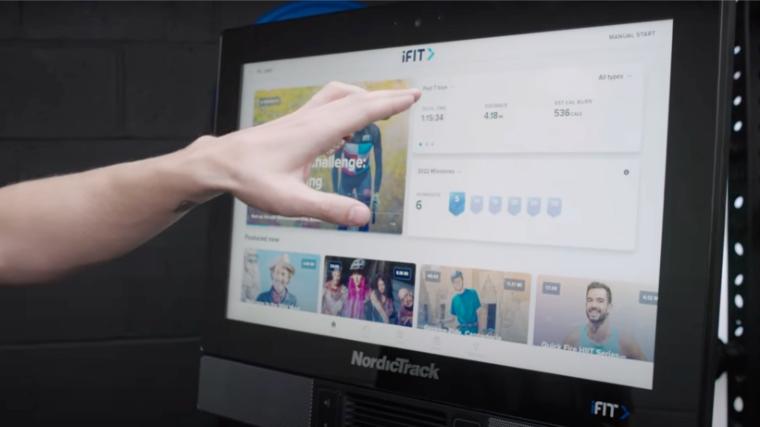
If you opt for a bike with an unlocked display (like the CAROL bike) or one that doesn’t come with a display at all (like the Bells of Steel Blitz Spin Bike), you’ll have a lot more freedom to stream whatever workouts you want. This gives you more variety and allows you to find what you like best.
Less Expensive
Peloton bikes aren’t cheap. Their most affordable option (at full price) is nearly $1,500, which is likely as much as or close to the amount you spend on rent or a mortgage each month. If budget is the most important factor for you, opting for a Peloton alternative can help you drastically reduce your workout costs. If you buy one of the budget picks here, you can spend as little as $600 or $300 on an exercise bike, which frees up about $1,000 to use for workout streaming subscriptions, other equipment, or, heck, even rent.
Stronger, More Compact Builds
A number of the Peloton alternatives here have smaller footprints and weigh less (sometimes, on account of not including a bulky screen), which can be friendlier to small living spaces or those who want to be able to stash their bike out of sight when not in use. In terms of strength, nearly all exercise bikes these days are built with welded steel frames, but they don’t all come with the same max user weight limit. And truthfully, Peloton’s bike is not the most accessible. If you’re close to or over Peloton’s weight limit of 297lbs, opting for an alternative with a higher user capacity can give you a safer, more comfortable ride.
How Much Do Peloton Alternatives Cost?
At-home exercise bikes come at a wide range of price points, from $300 to $3K. The Peloton Bike and Bike+, specifically, go for $1,445 and $2,495 at full price and represent the middle-to-upper range of the market. That said, Peloton also currently offers monthly bike rentals (starting at $80/month) and the option to buy refurbished machines (for as little as $995) if you’re looking to get one for less.
| Best Peloton Alternative Overall | ProForm Studio Bike Pro | $1,404 |
| Best Recumbent Peloton Alternative | Sole LCR Exercise Bike | $1,799 |
| Best Peloton Alternative for Live Classes | NordicTrack S22i | $1,999 |
| Best Peloton Alternative Under $500 | Sunny Health & Fitness SF-B1879 Synergy Exercise Bike | $419.99 |
| Best Budget Peloton Alternative | Bells of Steel Blitz Spin Bike | $599.99 |
| Best Peloton Alternative for Heavy People | Echelon EX-8s | $2,999.99 |
| Best Peloton Alternative for Small Spaces | CAROL Bike | $2,595 |
| Best Peloton Alternative with No Subscription | Stryde Bike | $1,895 |
If you’re looking for a Peloton-esque experience, you’ll probably end up spending around that price point; to get a bike with a screen and digital connectivity, you’re looking at at least $1K, plus a monthly subscription fee. If you’re okay with going low-tech and bringing your own screen or streaming device, you can knock the price down closer to $500. And if you want a machine with high-tech features, like automatic resistance adjustments, you’re looking at $2K+, no matter the brand. No one bike has it all at a low price, so you’ll need to weigh what’s worth it for you, as well as how much you’re willing to pay for a potential monthly membership.
What to Consider Before Buying a Peloton Alternative
Before buying any piece of exercise equipment, you don’t only have to weigh the product options, but also your priorities. Here are some key things to consider before you take the plunge — including an honest look at your budget (for the bike and potential subscription costs), the workout style you prefer, and whether or not you should maybe just get a Peloton.
Are You Sure You Don’t Just Want a Peloton?
Here’s the thing: Depending on exactly what you’re looking for, it might be worth it just to get a Peloton Bike or Bike+. The brand’s bikes work seamlessly with their streaming platform, and if you want a bike with built-in display, you’re likely to pay just as much money for another model that forces you to subscribe to a different platform like iFIT or JRNY. If you have no allegiance to the Peloton platform or workouts, that might be a fine option, but if it’s Peloton workouts you’re looking for, you may be better off just buying the brand’s bike. The one exception: If you’re looking to buy a bike sans display, and plan to stream Peloton workouts on your own device.

Peloton has some pretty good options for saving money, too. At the time of writing, Peloton is offering refurbished models for up to $400 off, which brings the price of the Bike down to under $1,000 and the Bike+ to $1,595. You can also rent a Peloton Bike or Bike+ if you’re unsure; after a $150 delivery fee, it costs just $80/month for a bike or $119/month for a Bike+, with a Peloton Rental Membership included, and you can choose to cancel or buy-out the bike (at a reduced rate) at any time.
Streaming Preferences
This is perhaps the biggest thing to think about when you’re considering the eight options above as Peloton alternatives. Are you open to using any streaming platform? Or do you want a bike that you can use with Peloton’s classes? In the latter case, you’ll want to buy a bike without a built-in screen or one that is certain to work with the Peloton app.
And if you plan to take Peloton’s classes on this bike, you’ll also want to keep in mind that their cycling classes are designed to be done on a cycling-style stationary bike — one that can handle pedaling out of the saddle, fast RPMs, and precise resistance adjustments. You may be able to make do with a recumbent bike, but it’s not going to be an ideal experience; you won’t be able to follow instructor cues properly or ramp up your intensity past a certain point.
Peloton’s app is, honestly, what all other streaming services are trying to be. They have a library of tens of thousands of on-demand workout classes across 13+ modalities and typically host 20+ live workouts per day. Extras like weeks-long workout programs, challenges, the ability to preload classes for offline use, a detailed music interface, and interactive leaderboards only serve to bolster the experience. The one thing they don’t offer that other platforms (notably, iFIT) do, are scenic classes that take you through real natural landscapes.
Price
With home workout equipment, you more or less get what you pay for — and if you’re looking for a Peloton-level experience, you’ll want to cough up the cash accordingly. “Peloton-esque bikes have become ultra-popular among people who love the fitness studio vibes that come from interactive workout sessions, both live and pre-recorded. If this is something you’re interested in, be prepared to shell out a significant amount of cash and also pay for a monthly subscription,” says BarBend expert reviewer Amanda Capritto, CPT, CES, CNC, CF-L1, CSNC. “Budget-friendly options are available, but comparatively lack in the tech department.”
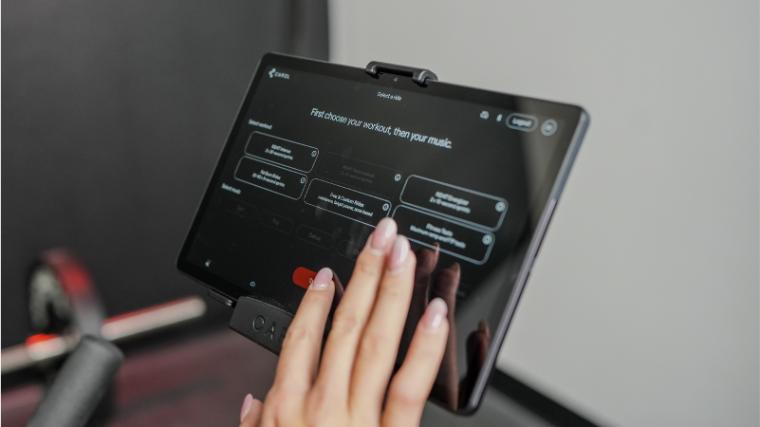
You can save money by buying a bike without a screen and streaming workouts on your phone, tablet, computer, or TV, though you’ll have less (if any) connectivity to get stats from your ride, including real-time feedback on your resistance level and cadence (which is a big part of following instructor cueing in Peloton classes).
That kind of setup will cost you around $500 and typically give you access to more affordable streaming memberships (for example, Peloton’s is $25 instead of $44/month when you don’t own a Peloton bike). Level up to get a bike with a built-in display, and you’ll need to pay more (from $1,000 to $3,000) but also may get locked into one specific streaming service as well as a monthly subscription cost, which can range from $15 to $44/month.
Final Word
Truthfully, if you have your heart set on a Peloton, it may be better to just go for it — especially with the brand’s current money-saving options to buy refurbished bikes or rent. But if a Peloton isn’t in the cards for you, whether due to the bike’s weight capacity, physical footprint, or overall cost including subscription fees, then one of these best Peloton alternatives should fit your needs.
You’ll need to carefully consider what’s most important to you: Is it access to Peloton’s classes and best-in-industry instructors? Or are you flexible on where you get your workouts, as long as you have a spot to do indoor cardio? And do you really want to buy another screen? With a little bit of self-reflection and an honest look at your budget and needs, you’re sure to find that one of these Peloton alternatives (or Peloton bikes) looks just right for you.
FAQs
What is the best Peloton alternative?
The best Peloton alternative for you will depend on exactly what you’re looking for. If you’re looking for a cycling-style stationary bike with immersive classes, a display screen, and at a friendlier price than a Peloton, we feel confident about our overall pick, the ProForm Studio Bike Pro. If you’re looking for a bike to use with Peloton classes, you’d be better off with the CAROL Bike since it allows you to stream Peloton classes directly on the screen. And if you’re on a budget, go for a screenless model like the Sunny Health & Fitness SF-B1879 Synergy Exercise Bike or Bells of Steel Blitz Spin Bike, which allows you to save a love of cash and still indoor cycle.
What app is similar to Peloton?
If you’re looking for live and on-demand studio-style classes, iFIT is one of your best bets (and we’re big fans of it here at BarBend). In addition to studio-style classes, iFIT also has scenic workouts that allow you to bike, run, row, etc., in beautiful places all over the world. Other options for fitness apps similar to Peloton include JRNY, Obé Fitness, Nike Training Club, and Alo Moves.
Can you watch Netflix on Peloton?
Yes (finally)! In late 2023, Peloton launched Peloton Entertainment, a new feature that allows you to stream live TV, sports, shows, and movies on the brand’s cardio machines. Available apps include Netflix, HBO Max, Disney+, YouTube TV, and NBA League Pass — these options will likely keep expanding. “Streaming service availability on Peloton Entertainment is subject to change and some streaming services may be added or removed in the future,” per the brand.
References
- Reiser, R. F., 2nd, Broker, J. P., & Peterson, M. L. (2004). Knee loads in the standard and recumbent cycling positions. Biomedical sciences instrumentation, 40, 36–42.
- Wang, Y., Liang, L., Wang, D., Tang, Y., Wu, X., Li, L., & Liu, Y. (2020). Cycling with Low Saddle Height is Related to Increased Knee Adduction Moments in Healthy Recreational Cyclists. European journal of sport science, 20(4), 461–467. https://doi.org/10.1080/17461391.2019.1635651